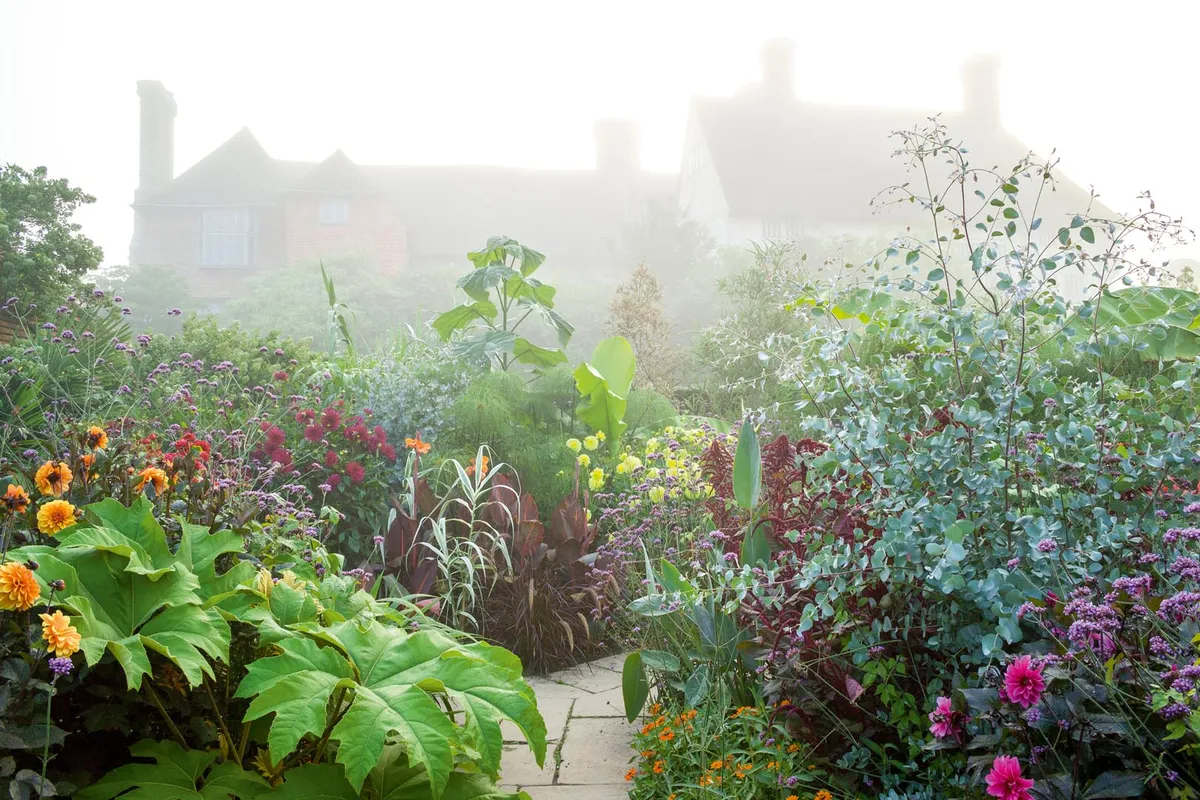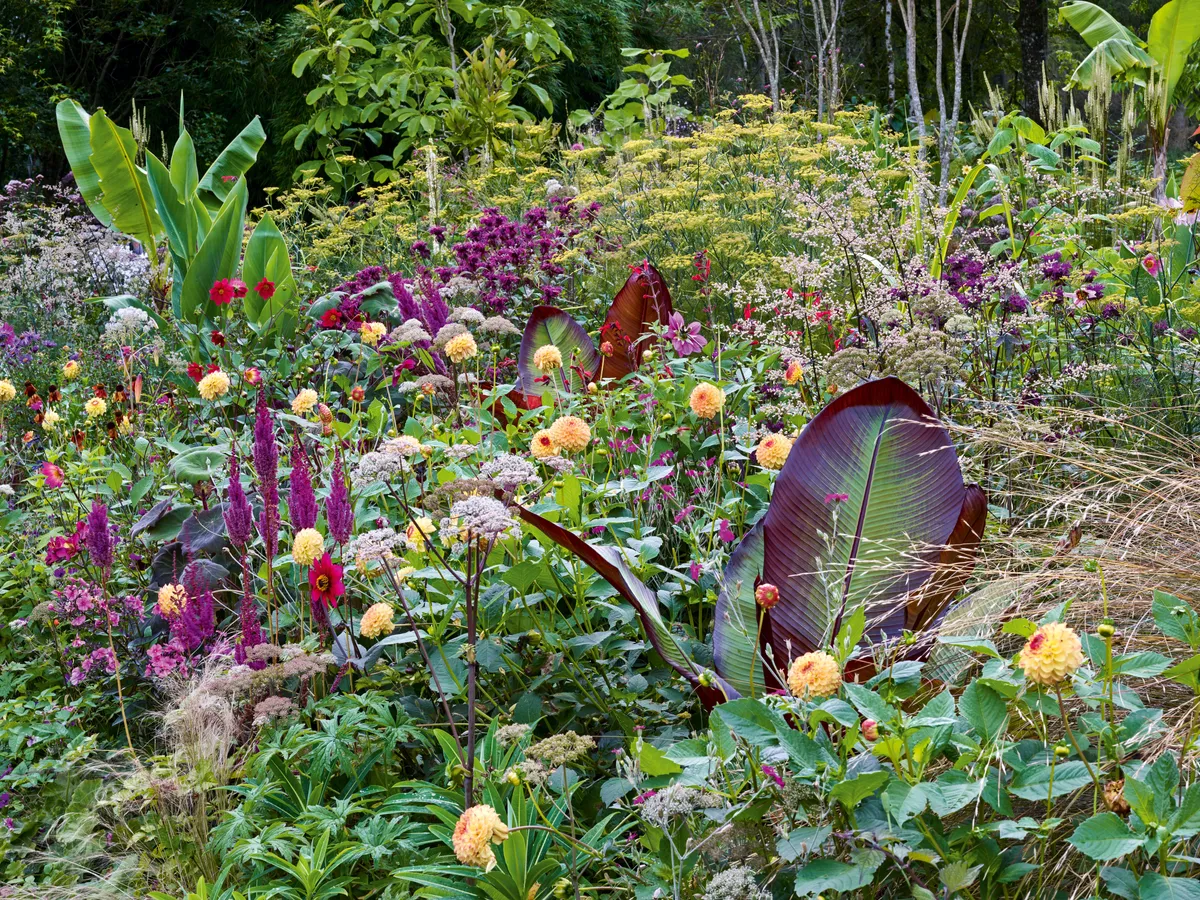In its original sense the term ‘exotic’ could be applied to anything non-native, but more often it conjures up images of curious things from faraway places, colourful and extraordinary objects, exciting people with alluring and sensual features, and plants with extraordinary shapes and textures. Exotic places makes you think of hot, steamy jungles dripping with lushness, where tree frogs and monkeys emit deafening sounds, and slithering anacondas and silky black panthers await in the shadows.

And so when Christopher Lloyd wanted to create an exotic garden at Great Dixter back in 1993, he imagined an other-worldly place ablaze with colour from cannas and dahlias, and swashbuckling bold foliage. I, on the other hand, visualised a scene out of a Rousseau painting, with palms and large green leaves creating a place of mystery. But like the great post-impressionist himself, neither of us had ever seen a real jungle, so our imaginations took over. The resulting hybrid was a mix of colour and daring, connected by seams of green, with touches of the bizarre and curious.
Don't miss our exotic garden inspiration list below
Planting an exotic garden
We could have concentrated on tropical plants alone. These are the lushest and most extravagant of all – but these aren’t easy to grow in East Sussex, as they need 100 per cent humidity with constant heat. They would thrive in a conservatory, but we wanted to play outside. More suitable for the UK climate are the exotica from the subtropics – the climatic zone between the tropics and the temperate – which can be divided into the humid subtropics, where the rainy season coincides with the summer, and the dry subtropics, such as the Mediterranean, with hot, dry summers and mild, wet winters. Plants from these areas can withstand our mild summers and cooler nights, but still provide a huge range of shapes and textures.
It’s interesting how extreme climate and growing conditions have shaped the way plants look. The climatic diversity of the tropics and subtropics is matched by a wealth of different cacti and succulents. These are the most architectural exotics of all, sculpted in arid sandy or rocky deserts, developing an array of extraordinarily peculiar shapes and textures. Spiky agaves, fuzzy opuntias, furry kalanchoes and fleshy blue senecios are all wonderfully bizarre and exotic in the true sense.

Also, there are many hardy plants that give us a feeling of exotica – usually those with large leaves or interesting shapes. Glossy leaved ferns, pollarded paulownias, coppiced sumacs, elegant bamboos and strappy phormiums will all do this.
Plant with a wide variety
Rather than stick to one group we decided to pull on a wide range, giving us the richest and most diverse picture. But, compatibility had to be considered. A succulent will not grow side by side with a tropical – they need different conditions. A black colocasia looks extraordinary among fleshy blue senecios, but one requires water and the other doesn’t.
Another consideration is spacing, as a grey, weeping conifer may contrast with the purple sugar cane, but in a hot year the latter outgrows and smothers the other. Different plants have different responses to heat and water. Some shut down when it’s too hot while others romp away, making correct spacing difficult. In an ideal world you want an intimate yet clear picture not a congested mass, and so plants that respond to heat similarly make better bedfellows.
Shelter is key
A sheltered location is also important as strong winds can desiccate and shred large leaves. Cacti won’t mind but broad-leaved tropicals need protection. The space at Dixter was perfect: sheltered on all four sides with yew hedging and an old building.
Visual connections
When constructing our combinations we had to make sure that plants visually connected. It’s no good having a large banana with a tiny fern because they are not intimate. But a banana hugging the rounded leaves of coppiced paulownias, next to the upright stems of Arundo donax, then stepping down to dark-leaved cannas, and then Persicaria virginiana ‘Brushstrokes’, all play off one another, contrasting in shape and texture. Producing pictures with exotic plants is relatively easy as they are all strong characters and it’s a case of working one off another while making sure they are compatible.
Read our piece on the best exotic plants to grow
